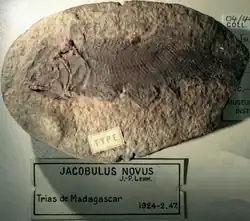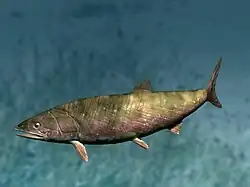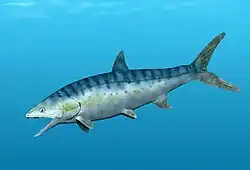Jacobulus
| Jacobulus Temporal range:
| |
|---|---|

| |
| Jacobulus novus type | |
| Scientific classification | |
| Kingdom: | Animalia |
| Phylum: | Chordata |
| Class: | Actinopterygii |
| Order: | †Parasemionotiformes |
| Family: | †Parasemionotidae |
| Genus: | † Lehman, 1952 |
| Type species | |
| †Jacobulus novus Lehman, 1952
| |
Jacobulus is an extinct genus of prehistoric ray-finned fish that lived during the Early Triassic epoch in what is now northern Madagascar 252.3 to 251.3 million years ago.[1][2] The type species is Jacobulus novus (monotypy). It was a small fish less than 10 centimetres (3.9 in) in length. J. novus ecology was a grazer-detritivore. It belongs to the Parasemionotidae together with Albertonia, Candelarialepis, Icarealcyon, Lehmanotus, Parasemionotus, Qingshania, Stensioenotus, Suius, Thomasinotus, and Watsonulus.
See also
References
- ^ a b Sepkoski, Jack (2002). "A compendium of fossil marine animal genera". Bulletins of American Paleontology. 364: 560. Archived from the original on July 23, 2011. Retrieved 2009-02-27.
- ^ "Fossilworks: Jacobulus". Paleobiology Database. Retrieved 2022-07-03.

